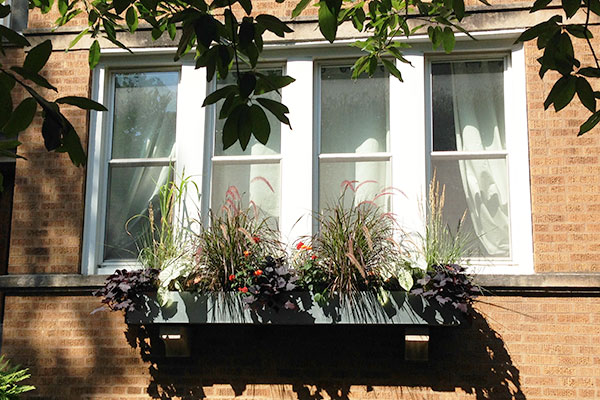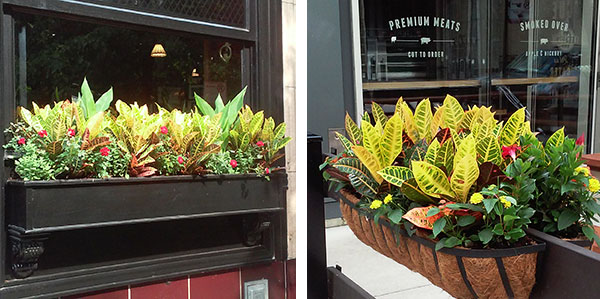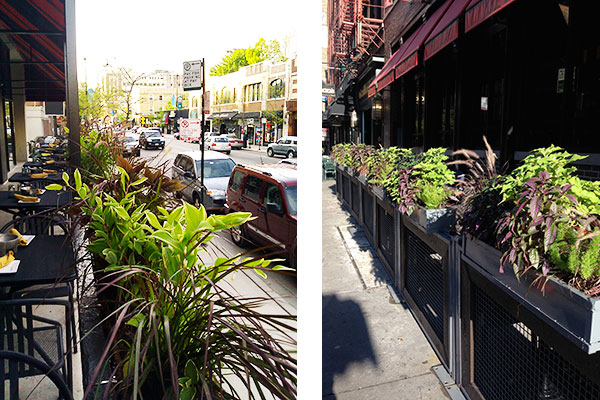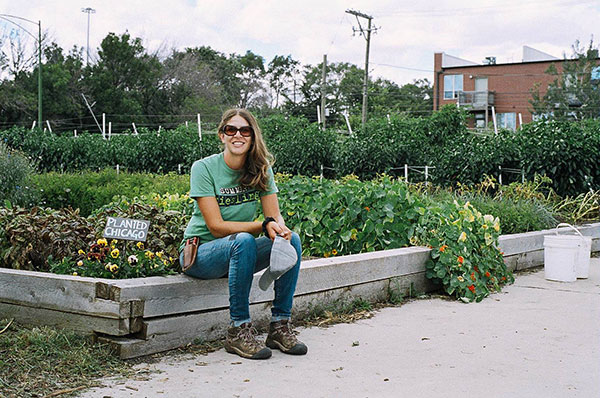The planting season is in full swing in Chicago! Flowers and plants add a relaxing retreat to any outdoor space. With all the amazing, neighborhood garden walks, there's plenty of inspiration. For curb appeal, consider the style of your home so the design will seamlessly move from the exterior of your home to the interior. Here are some simple tips from local garden specialists on how to plant and maintain your garden all summer long!

Photo credit: Flowerlife
Window Boxes and Flower Containers
At this point in the season, Joanne Greene, owner of On the Ledge Landscaping says your best bet to designing a beautiful outdoor space is to create a container garden. Using containers are a simple way to add color and beautiful touches to your balcony, rooftop and outdoor patio space.

Photo credit: On the Ledge Landscaping
The first step to a beautiful container is fertile soil with proper drainage. “The soil should be pre-moistened and easily crumble out of your hands–not too wet or dry. And fertilize during the summer,” explained Ananda Breslof, owner of Flowerlife. She advised to water two times a day in the heat–first thing in the morning and late afternoon. Watering midday might lead to scorched flowers.
Joanne Charron, owner of Cartwheel Gardens confirmed this and added that plants in the shade require less water. “If you let the pot dry out, the water will run through–don't think you're overwatering, let the soil soak up the moisture and do it again.”

Photo credit: On the Ledge Landscaping
When combining plants in containers and boxes, Breslof advised not to crowd the planter. “Work with what pleases you. I love combining deep colors with very pale ones–it adds depth to the display. Taller plants provide height and hanging plants create a lush waterfall effect that can be seen mid summer.”

Photo credit: On the Ledge Landscaping
Greene added that using oregano as a draping plant at the edge of your container looks gorgeous and smells delicious.
Breslof’s current favorite plants are fountain grasses with punches of color and country flowers. “Using simple clean whites, variegated wild grass and Caladium is an elegant approach for the modern home,” she explained. “Relax and have fun planting, it’s therapeutic and helps you feel calm and inspired!”

Photo credit: Flowerlife
Landscape Design
Charron advised to avoid the planting panic of May. “You can plant any time you want–just make sure to water it profusely afterwards if it happens to be a very hot day. June is the best time to plant in Chicago.” She recommended plants in Zone 2-6. “Sometimes the plant requires soil needs we don't have, even if it's a tough zone 4. If you want on-going color in the summer go for tropicals–they last up to the first frost and sometimes beyond.”

Photo credit: On the Ledge Landscaping
Maintenance begins with a design and plants that match your skill level in the garden. Greene recommended choosing plants you are comfortable to work with. Simple, functional designs are best. Keep garden beds weed free, often with the aid of weed fabric. Once flowers bloom, “deadhead” or cut back the flowers to encourage new growth. Watering three to four times a week will produce a beautiful landscape garden. A good designer can add to your plan as you gain experience.

Photo credit: On the Ledge Landscaping
At the end of July, Ball Horticultural Company opens it’s trial gardens to the public to offer a glimpse into the beautiful flowers that will be available the following spring. “Look for new DNA stunners that sparkle in your garden–these new shapes, sizes, colors and profuse bloomers create magical gardens–no extra work involved,” Greene explained.

Photo credit: On the Ledge Landscaping
Edible Gardens
“The biggest mistake in gardening is not starting because you’re afraid to fail,” said Jen Rosenthal, Owner/Consultant for Planted | Chicago, “read, figure it out, and play with it.”
Growing herbs is one of the best ways to start. Herbs work better when they’re in their own container because some, like mint, will take over a landscape. Some also need more water than others.
Cilantro is a cool weather plant. They key is to cut cilantro regularly to keep it alive, otherwise it will bolt leaving you with coriander seeds. Pinch basil flower heads to prolong life. Basil needs heat–it turns black with cold damage. If you purchase basil, put it in a cup of water on your counter to prolong the life. Other favorite herbs are sage, parsley, oregano, rosemary and thyme.

Photo credit: Planted | Chicago
Vegetables should be planted early to mid June. When shopping for vegetable plants, find varieties with shorter days to maturity, 60-70 days to maturity, when the first fruit is ready to eat.
The soil in Chicago might be toxic. Rosenthal recommended testing the soil or using raised beds with weed block material. EarthBox, with a built-in irrigation system is a simple way to maintain and grow vegetables. If you don’t have a self-watering system in your raised bed, they require deep watering, less frequently. A quick way to check if it’s dry is to stick your finger in the soil two to three inches. Tomatoes, peppers, cucumbers, squash and eggplant need full sun and require a lot of water. A benefit to growing these varieties is that they keep producing fruit.
With root vegetables, you get one fruit and they are harder to grow. If you do grow vegetables such as radish, beets, carrots, onions and scallions, plant them in full sun otherwise they won’t produce the root. Egyptian walking onions and gigantic scallions form flower heads that fall into the garden for multiple, re-seeding.

Photo credit: Planted | Chicago
Leafy greens, such as kale, Swiss chard, lettuce, arugula and spinach are best when planted in the spring and fall when it’s cooler. Some varieties of lettuce can grow in summer, as long as they are in shade during the hottest time of day. You can cut leafy greens two to three times before they lose their flavor and turn bitter. These plants will bolt, which means they grow a flower sprout in attempt to drop seeds for a new harvest.
Apples, nectarines, peach and cherry trees need a lot of room. Consult with a specialist to get spacing advice. Blueberries and strawberries can be grown in big containers. You will need two blueberry plants–they can be two varieties, to cross-pollinate. It’s best to consult with your local garden center when choosing the right plants.

